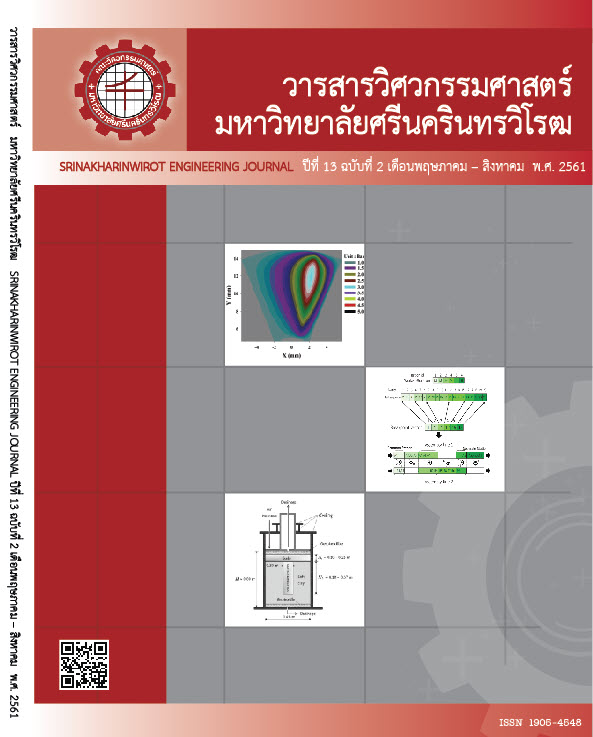Assessment an Areal Rainfall Technique with Digital Elevation Model Data in Tapi Basin
Main Article Content
Abstract
This study aims to compare the areal daily rainfall interpolation derived from ground measurement rainfall by applying 3 techniques of areal interpolation: Co-Kriging, Thin plate spline, and Thiessen polygon. All the techniques were used with SRTM-DEM numerical topographic information of NASA whose horizontal resolution is 90 meters by using daily rainfall data from 12 rainfall stations in Tapi Basin and 8 adjoining stations. This study focused on rainfall data in November 2010, March2011, November2011, and January2012 by testing the accuracy of the interpolation using ME, MAE and RMSE. The result shows that in southern part, whose topography is plain area with few mountains, ME from all methods were negative which means that the interpolation was over-estimated. It was also found that the best ME and RMSE came from Thin plate spline technique, following by Co-Kriging and Thiessen Polygon, respectively. The Thin plate spline is suitable areal rainfall interpolation in Tapi Basin.
Article Details
Copyright belongs to Srinakharinwirot University Engineering Journal
References
[2] กีรติ ลีวัจนกุล, อุทกวิทยา, ปทุมธานี: สำนักพิมพ์มหาวิทยาลัยรังสิต, 2543.
[3] เฉลิมชัย เอกก้านตรง, การศึกษาและวิเคราะห์ด้านอุตุนิยมวิทยาที่มีอิทธิพลต่อการเกิดอุทกภัยในภาคใต้ของประเทศไทย ระหว่างวันที่ 18-26 พฤศจิกายน 2543, กรุงเทพมหานคร: กรมอุตุนิยมวิทยา, 2543.
[4] ประกอบ วิโรจนกูฎ, “การหาปริมาณน้ำฝนบนพื้นที่โดยวิธี KRINGING,” วิศวกรรมสาร มหาวิทยาลัยขอนแก่น, ปีที่21, หน้า 29-43, มกราคม-กุมภาพันธ์, 2537.
[5] รังสรรค์ อาภาคัพภะกุล, อุตุนิยมวิทยาเบื้องต้น, กรุงเทพฯ: สำนักพิมพ์แห่งจุฬาลงกรณ์มหาวิทยาลัย, 2547.
[6] รัศมี สุวรรณวีระกำธร, “การเปรียบเทียบวิธีการประมาณค่าน้ำฝนเชิงพื้นที่ด้วยระบบสารสนเทศภูมิศาสตร์ กรณีศึกษาพื้นที่ลุ่มน้ำเชิญ,”วารสารสมาคมสำรวจข้อมูลระยะไกลและสารสนเทศภูมิศาสตร์, ปีที่1, หน้า 35-48, กันยายน-ธันวาคม, 2543.
[7] วิษุวัฒก์ แต้สมบัติ, “การประมาณค่าเชิงพื้นที่ของข้อมูลปริมาณน้ำฝนรายวัน โดยวิธี Thin Plate Smoothing Spline สำหรับลุ่มน้ำปิงตอนบน,” ใน การประชุมทางวิชาการ, มหาวิทยาลัยเกษตรศาสตร์ วิทยาเขตกำแพงแสน นครปฐม ครั้งที่ 4, 2550.
[8] วิษุวัฒก์ แต้สมบัติ, อุทกวิทยาทางวิศวกรรม (เอกสารประกอบการสอน), นครปฐม: ภาควิชาวิศวกรรมชลประทาน คณะวิศวกรรมศาสตร์ มหาวิทยาลัยเกษตรศาสตร์ วิทยาเขตกำแพงแสน, 2555.
[9] วีระพล แต้สมบัติ, หลักอุทกวิทยา, กรุงเทพมหานคร: สำนักพิมพ์ฟิสิกส์เซ็นเตอร์, 2528.
[10] สุเพชร จิรขจรกุล, เรียนรู้ระบบภูมิสารสนเทศด้วยโปรแกรม ArcGIS Desktop 10.1, กรุงเทพมหานคร: ภาควิชาเทคโนโลยีชนบท มหาวิทยาลัยธรรมศาสตร์, 2555.
[11] เอกสิทธิ์ โฆสิตสกุลชัย, การหาค่าการใช้น้ำของพืชในโครงการชลประทานขนาดใหญ่โดยใช้การสำรวจระยะไกล, กรุงเทพมหานคร: มหาวิทยาลัยเกษตรศาสตร์, 2547.
[12] สายสุนีย์ พุทธาคุณเจริญ, วิศวกรรมอุทกวิทยา, กรุงเทพมหานคร: ไลบรารี่ นายน์ พับลิชชิ่ง, 2546.
[13] พีระพงศ์ รัตนบุรี, “การเปรียบเทียบการประมาณฝนเชิงพื้นที่ของลุ่มน้ำปิงตอนบนและลุ่มน้ำท่าจีน โดยเทคนิคการประมาณค่าเชิงพื้นที่,” วิทยานิพนธ์ปริญญาโท ภาควิชาวิศวกรรมชลประทาน มหาวิทยาลัยเกษตรศาสตร์, กรุงเทพมหานคร, 2557.
[14] H. Apaydin, F. Sonmez and Y. Yildirim, “Spatial interpolation techniques for climate data in the GAP region in Turkey,” Climate Res., vol. 28, no.1, pp. 31–40, 2004.
[15] P. Burrough, R. McDonnell and C. Lloyd, Principles of Geographical Information Systems, Oxford, Oxford University Press, 2015.
[16] C. Chang, S. Lo and S. Yu, “The parameter optimization in the inverse distance method by genetic algorithm for estimating precipitation,” Environ. Monitor. Assess, vol. 117, no. 1-3, pp. 145–155, 2006.
[17] V. Chaplot, F. Darboux, H. Bourennane, S. Leguédois, N. Silvera and K. Phachomphon, “Accuracy of interpolation techniques for the derivation of digital elevation models in relation to landform types and data density,” Geomorphology, vol. 77, no. 1-2, pp. 126–141, 2006.
[18] P. Goovaerts, “Geostatistical approaches for incorporating elevation into the spatial interpolation of rainfall,” J. Hydro., vol. 228, no. 1-2, pp. 113–129, 2000.
[19] M. Hutchinson, “Interpolating mean rainfall using thin plate smoothing splines,” Inter. J. Geogr. Inform. Syst., vol. 9, no. 4, pp. 385–403, 1995.
[20] M. Hutchinson and P. Gessler, “Splines — more than just a smooth interpolator,” Geoderma, vol. 62, no 1-3, pp. 45–67, 1994.
[21] W. Taesombat and N. Sriwongsitanon, “Areal rainfall estimation using spatial interpolation techniques,” Sci. Asia, vol. 35, no. 3, pp. 268-275, 2009.


